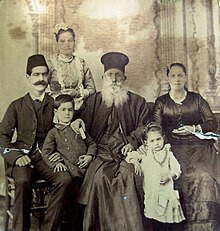
Back زواج رجال الدين Arabic Pastra geedzeco Esperanto Matrimonio clerical Spanish Clérogamie French Pernikahan rohaniwan ID Klerogamija Serbo-Croatian

Clerical marriage is the practice of allowing Christian clergy (those who have already been ordained) to marry. This practice is distinct from allowing married persons to become clergy. Clerical marriage is admitted among Protestants, including both Anglicans and Lutherans.[1] Some Protestant clergy and their children have played an essential role in literature, philosophy, science, and education in Early Modern Europe.[2]
Many Eastern Churches (Assyrian Church of the East, Eastern Orthodox, Oriental Orthodox, or Eastern Catholic), while allowing married men to be ordained, do not allow clerical marriage after ordination: their parish priests are often married, but must marry before being ordained to the priesthood. Within the lands of the Eastern Christendom, priests' children often became priests and married within their social group, establishing a tightly knit hereditary caste among some Eastern Christian communities.[3][4]
The Latin Catholic Church as a rule requires clerical celibacy for the priesthood since the Gregorian Reform in the late 11th century under the influence of Bernard of Clairvaux, but Eastern Catholic Churches do not require clerical celibacy for the priesthood and the Latin Catholic Church occasionally relaxes the discipline in special cases, such as the conversion of a married Anglican priest who wishes to be ordained a Catholic priest. (Celibacy is, however, a requirement to become a bishop.)
- ^ Tjerngren, Beverly (2021). The Social Life of the Early Modern Protestant Clergy. University of Wales Press. p. 3. ISBN 9781786837158.
- ^ Schorn-Schütte, Luise (2003). The Social Life of the Early Modern Protestant Clergy. Springer. p. 62. ISBN 9780230518872.
- ^ W. Braumüller, W. (2006). The Rusyn-Ukrainians of Czechoslovakia: An Historical Survey. University of Michigan Press. p. 17. ISBN 9783700303121.
because Eastern Christian priests were allowed to marry and therefore the clergy soon became somewhat of a caste made up of a closely - knit families
- ^ Tarnavky, Spohady, cited in Jean-Paul Himka. (1986). The Greek Catholic Church and Ukrainian Society in Austrian Galicia. Cambridge, MA: Harvard University Press pg. 444
© MMXXIII Rich X Search. We shall prevail. All rights reserved. Rich X Search